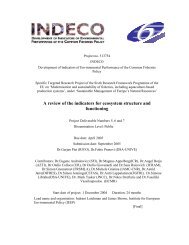WP5 Case study on genetic resources in food and agriculture
WP5 Case study on genetic resources in food and agriculture
WP5 Case study on genetic resources in food and agriculture
You also want an ePaper? Increase the reach of your titles
YUMPU automatically turns print PDFs into web optimized ePapers that Google loves.
6 ItalyItaly is the country with <strong>on</strong>e of the highest number of breeds at risk with<strong>in</strong> the EU15 butat the same time a comparably high level of support through AEMs (Signorello <strong>and</strong>Pappalardo, 2003). Follow<strong>in</strong>g Reg. (EC) No.2078/92, there were AEMs with<strong>in</strong> 15regi<strong>on</strong>al programmes, which addressed ‘rear<strong>in</strong>g animals of local breeds <strong>in</strong> danger ofext<strong>in</strong>cti<strong>on</strong>’, <strong>and</strong> around 100 different animal breeds have been supported (Cicia et al.2001). Under Reg. (EC) No.1257/1999, all regi<strong>on</strong>s, except Basilicata <strong>and</strong> Calabria, haveset up AEMs for the c<strong>on</strong>servati<strong>on</strong> of breeds under risk of ext<strong>in</strong>cti<strong>on</strong> (38,200 livestockunits supported <strong>in</strong> 2002), with the regi<strong>on</strong>s support<strong>in</strong>g the highest number of livestockunits be<strong>in</strong>g the Emilia-Romagna (10,000), Piem<strong>on</strong>te (7,500) <strong>and</strong> Lazio (5,700) (Oreade-Breche, 2005). In the Emilia-Romagna the spread of organic farm<strong>in</strong>g is said to havec<strong>on</strong>tributed to the <strong>in</strong>terest <strong>in</strong> the measures. Some regi<strong>on</strong>s as well offer support for certa<strong>in</strong>plant varieties. Such examples are the Emilia-Romagna, where premiums for certa<strong>in</strong>species of apple trees <strong>and</strong> grape v<strong>in</strong>es apparently have showed a str<strong>on</strong>g effect (Oreade-Breche, 2005) or the Veneto, where some varieties of barley <strong>and</strong> maize are supported(B<strong>on</strong>nieux et al., 2004).Italy is an outst<strong>and</strong><strong>in</strong>g example <strong>in</strong> Europe of comb<strong>in</strong><strong>in</strong>g <strong>food</strong> culture <strong>and</strong> traditi<strong>on</strong>s withthe c<strong>on</strong>servati<strong>on</strong> of <strong>genetic</strong> <strong>resources</strong>. In Italy, there has been an <strong>in</strong>creased awareness ofloss of envir<strong>on</strong>mental values c<strong>on</strong>nected with <strong>genetic</strong> erosi<strong>on</strong> <strong>and</strong> at the same time<strong>in</strong>creased dem<strong>and</strong> for typical products derived from some endangered breeds (Cicia et al.2001). E.g. the Emilia-Romagna tries to <strong>in</strong>crease the commercial value of products fromlocal breeds through the <strong>in</strong>troducti<strong>on</strong> of new quality marks (Oreade-Breche, 2005). TheSlow Food movement, now an <strong>in</strong>ternati<strong>on</strong>al associati<strong>on</strong>, was founded <strong>in</strong> Italy <strong>in</strong> 1986 <strong>and</strong>promotes <strong>food</strong> <strong>and</strong> w<strong>in</strong>e culture, but also aims at preserv<strong>in</strong>g <strong>food</strong>s <strong>and</strong> cultivati<strong>on</strong> <strong>and</strong>process<strong>in</strong>g techniques <strong>in</strong>herited from traditi<strong>on</strong> <strong>and</strong> domestic <strong>and</strong> wild animal <strong>and</strong>vegetable species. Of its 83,000 members worldwide, around 35,000 are from Italy(Slow<strong>food</strong> 2005). In 2003 the Slow Food Foundati<strong>on</strong> for Biodiversity was created. Itsmissi<strong>on</strong> is to organise <strong>and</strong> fund projects that defend the world’s heritage of agriculturalbiodiversity <strong>and</strong> gastr<strong>on</strong>omic traditi<strong>on</strong>s. While the Foundati<strong>on</strong> promotes projects aroundthe world, its direct f<strong>in</strong>ancial c<strong>on</strong>tributi<strong>on</strong>s are especially dedicated to the world's lessdeveloped countries. So called Presidia projects try to defend typical products at risk ofdisappear<strong>in</strong>g <strong>and</strong> especially support small-scale producers <strong>in</strong> the way that they facilitatecooperati<strong>on</strong> between them <strong>and</strong> promoti<strong>on</strong> of the products as well as creat<strong>in</strong>g a ‚networkof experience‘, <strong>in</strong>clud<strong>in</strong>g <strong>in</strong>ternati<strong>on</strong>al exchanges. The primary partner of the Slow FoodFoundati<strong>on</strong> for Biodiversity is the Regi<strong>on</strong> of Tuscany, which has a l<strong>on</strong>g history ofimportant cultural <strong>in</strong>itiatives, l<strong>in</strong>ked to promot<strong>in</strong>g <strong>and</strong> protect<strong>in</strong>g biodiversity <strong>and</strong>coord<strong>in</strong>ates various programmes for <strong>in</strong>ternati<strong>on</strong>al cooperati<strong>on</strong>. This Regi<strong>on</strong> promotestypical <strong>food</strong>s through a programme coord<strong>in</strong>ated by the Rural Agricultural DevelopmentAgency (ARSIA), <strong>and</strong> <strong>in</strong> this c<strong>on</strong>text has supported many Slow Food projects. Inadditi<strong>on</strong>, Tuscany was the first Italian regi<strong>on</strong> to <strong>in</strong>stitute a regi<strong>on</strong>al catalogue oftraditi<strong>on</strong>al <strong>food</strong>s. In 2003 Slow Food <strong>in</strong> c<strong>on</strong>juncti<strong>on</strong> with the regi<strong>on</strong>al authorities of35




